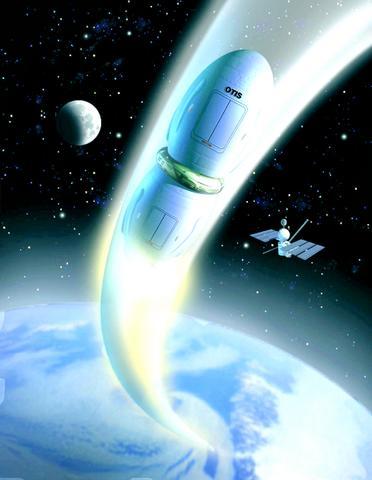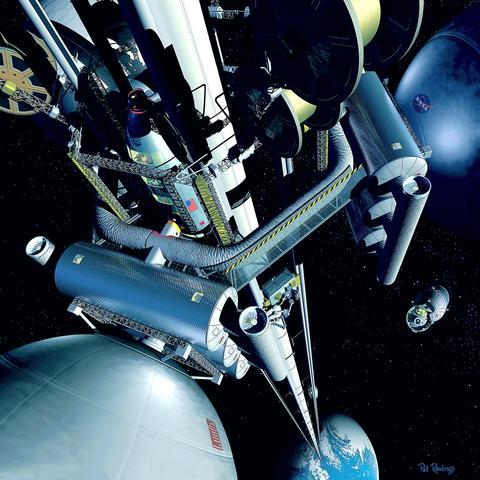With advances toward ultrastrong fibers, the concept of building an elevator 96,500km high to carry cargo into space is moving from the realm of science fiction to the fringes of reality.
This month, the Los Alamos National Laboratory was a sponsor of a conference to ponder the concept. Yet the keynote address was by a titan of science fiction, Arthur C. Clarke, speaking via satellite from his home in Sri Lanka. "I'm happy that people are taking it more and more seriously," said Clarke, whose novel The Fountains of Paradise (1978) revolved around such a space elevator.
The discovery in 1991 of nanotubes, cylindrical molecules of carbon with many times the strength of steel, turned the idea from a fantastical impossibility to an intriguing possibility that could be realized in as little as a decade or two.

Proponents say the economic and technological advantages of a space elevator over rockets make it inevitable. They predict it will lower the cost of putting a satellite into space from US$10,000 a pound to US$100.
"As soon as we can build it, we should build it," said Dr. Bryan E. Laubscher, a scientist at Los Alamos who organized the conference. Just as the transcontinental railroad opened the West in the late 1800s, "I feel the space elevator is going to be such a paradigm shift in space access," Laubscher said.
Easier economical access to space might also make practical other grandiose projects like solar-powered satellites that could collect sunlight and beam energy down to Earth.

GRAPHICS: NY TIMES
The conference, a three-day session here, drew 60 people, a mix of scientists and engineers who are working on the concept, space enthusiasts who wanted to hear more and dilettantes attracted by curiosity
"The first thought is: Is this really going to work?" said Dr. Steven Patamia, a researcher at Los Alamos, who was enlisted to perform space elevator calculations a week before the conference. "When you get into it, it begins to make sense. There are a good number of technical issues. They are probably all overcomable."
The original idea of a space elevator is more than a century old. In 1895, Konstantin Tsiolkovsky, a Russian visionary who devised workable ideas for rocket propulsion and space travel decades before others, proposed a tower thousands of miles high attached to a "celestial castle" in orbit around Earth, with the centrifugal force of the orbiting castle holding up the tower. (Imagine swinging a rope with a rock tied to the end of it.)
The idea was fundamentally impossible to build. Steel, then the strongest material known, was too heavy and not strong enough to support that weight.
Other scientists periodically revisited and reinvented Tsiolkovsky's idea, inspiring science fiction writers like Clarke.
Nanotubes spurred the National Aeronautics and Space Administration to take a more serious look in 1999. A team of scientists envisioned huge cables of nanotubes and magnetically levitated cars traveling up and down. The structure would be so large that it would require grabbing an asteroid and dragging it into Earth orbit to act as the counterweight for holding up the elevator.
To avoid weather, especially lightning, the NASA scientists envisioned the base station as a tower at least 16km high.
"We came out of that workshop saying the space elevator is 50 years away," said David Smitherman of the Marshall Space Flight Center, who led the study.
Around that time, Dr. Bradley C. Edwards, who was then a scientist at Los Alamos, read an even more pessimistic assessment, that a space elevator would not be built for at least 300 years.
"But there was no information why it couldn't be built," Edwards said, and he took that as a challenge. Edwards simplified the NASA idea to what he calls "the Wright brothers' version," a single ribbon about 1m wide and thinner than a piece of paper, stretching 96,500km from Earth's surface.
He sent a proposal to the NASA Institute for Advanced Concepts, which provided him US$570,000 to flesh out the ideas. His results are described in a book simply titled The Space Elevator (Spageo, 2002).
Instead of using magnetic levitation, the apparatus would lift up to 13 tons of cargo by pulling itself upward with a couple of tanklike treads that squeezed tightly onto the ribbon. Up to eight would ascend the ribbon at any one time, powered by lasers on the ground shining on the solar panels on the rising platforms.
It would take about a week for one to reach geosynchronous orbit, 35,500km up, where a satellite circles the earth in exactly one day, continuously hovering over the same spot on the earth's surface.
The first elevator would go up only. At the top, the platform would simply be added to the counterweight or be discarded into space.
All the necessary underlying technology exists, Edwards said, except the material for the ribbon. (The longest nanotube to date is a few meters long.) But he said he expected that scientists would develop a strong enough nanotube-polymer composite in a few years.
"There's a clear path to building this," said Edwards, now director of research at the Institute for Scientific Research, an independent organization in Fairmont, West Virginia. The institute sponsored the conference with Los Alamos.
Edwards estimates the cost to build the first elevator at US$6.2 billion, although with the uncertainties in forecasting a decade or two of research and development, "doubling this is probably a good first cut."
"It's gotten to the point," he added, "where we can say it's closer to US$6 billion than US$600 billion."
Building subsequent elevators would be cheaper, US$2 billion each, because the first elevator could lift materials.
By comparison, the estimated cost of building and operating the International Space Station is widely expected to exceed US$100 billion.
Edwards says he has reasonable solutions for other concerns. The elevator base could be a movable ocean platform in the eastern equatorial Pacific, hundreds of miles from commercial airline routes and easy to defend from terrorist attacks. Hurricanes never cross the Equator, and lightning is sparse in that region. By moving the base station, the elevator operators could drag the apparatus around low-orbit space debris. An aluminum coating could be added to parts of the ribbon to combat decay from the reaction of oxygen with carbon atoms in the nanotubes.
More futuristically, Edwards imagines that additional elevators can be built on the moon or Mars, simplifying and speeding spaceflight through the solar system.
"What a wonderful idea if you could ever make it work," said Gentry Lee, the chief engineer of planetary flight systems at NASA's Jet Propulsion Laboratory in Pasadena, California, who pushed for financing Edwards' initial studies. "It is plausible. It is not implausible. I think that the idea has so much promise a couple of million dollars a year aimed at the enabling technologies is not too much to ask."
At the conference, scientists presented calculations that examined details. Vibrations in the elevator ribbon, which would act like an extremely long plucked guitar string, appeared manageable.
Dr. Anders Jorgensen of Los Alamos raised concerns that as the ribbon swung around through the earth's magnetic field, it would create strong electric currents. Because of the elevator's relatively slow pace, a larger problem could be that any human passengers would receive dangerous doses of radiation as they passed through pockets of high-energy particles trapped in Earth's magnetic field.
The first space elevator would be built to carry only cargo, not people, Edwards said. The dangers could be reduced on subsequent elevators by speeding them up or providing shielding through magnetic fields.
The logistics of construction "appear to be an interesting problem, as well," said Carey Butler, a program manager at the Institute for Scientific Research.
The idea is to launch a spacecraft with the initial spools of ribbon into geosynchronous orbit. As the ribbon unspools and falls to the ground, the spacecraft moves higher to keep the center of mass, or balance point, at the same geosynchronous height. By the time the ribbon reaches the ground, the spacecraft has reached an altitude of 80,500km.
After the ribbon is attached to the base station, the spacecraft unfurls another 16,000km of ribbon. Then a series of about 230 mechanical construction platforms will ascend to stitch on additional ribbon.
While technologically feasible, years of engineering will still be needed. Nonetheless, Clarke, who came up with the idea of using satellites in geosynchronous orbit for communications long before any were launched, thought that he might live to see to live this science fiction idea come true, too.
"I'm 86 now," Clarke said. "So in 20 years' time, I'll only be 106. So maybe I will see it."

On April 26, The Lancet published a letter from two doctors at Taichung-based China Medical University Hospital (CMUH) warning that “Taiwan’s Health Care System is on the Brink of Collapse.” The authors said that “Years of policy inaction and mismanagement of resources have led to the National Health Insurance system operating under unsustainable conditions.” The pushback was immediate. Errors in the paper were quickly identified and publicized, to discredit the authors (the hospital apologized). CNA reported that CMUH said the letter described Taiwan in 2021 as having 62 nurses per 10,000 people, when the correct number was 78 nurses per 10,000

As we live longer, our risk of cognitive impairment is increasing. How can we delay the onset of symptoms? Do we have to give up every indulgence or can small changes make a difference? We asked neurologists for tips on how to keep our brains healthy for life. TAKE CARE OF YOUR HEALTH “All of the sensible things that apply to bodily health apply to brain health,” says Suzanne O’Sullivan, a consultant in neurology at the National Hospital for Neurology and Neurosurgery in London, and the author of The Age of Diagnosis. “When you’re 20, you can get away with absolute

May 5 to May 11 What started out as friction between Taiwanese students at Taichung First High School and a Japanese head cook escalated dramatically over the first two weeks of May 1927. It began on April 30 when the cook’s wife knew that lotus starch used in that night’s dinner had rat feces in it, but failed to inform staff until the meal was already prepared. The students believed that her silence was intentional, and filed a complaint. The school’s Japanese administrators sided with the cook’s family, dismissing the students as troublemakers and clamping down on their freedoms — with

As Donald Trump’s executive order in March led to the shuttering of Voice of America (VOA) — the global broadcaster whose roots date back to the fight against Nazi propaganda — he quickly attracted support from figures not used to aligning themselves with any US administration. Trump had ordered the US Agency for Global Media, the federal agency that funds VOA and other groups promoting independent journalism overseas, to be “eliminated to the maximum extent consistent with applicable law.” The decision suddenly halted programming in 49 languages to more than 425 million people. In Moscow, Margarita Simonyan, the hardline editor-in-chief of the